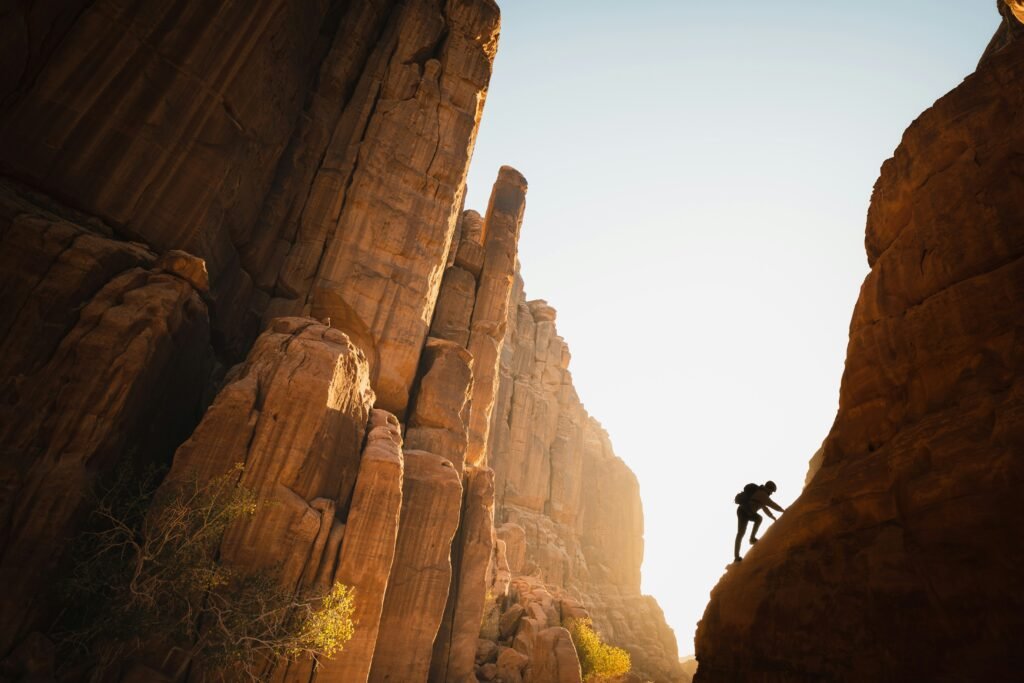Hey there, adventure-seeker! Get ready to take your off-roading skills to new heights with our Ultimate Guide to ATV Hill Climbing. Whether you’re a beginner looking to conquer your first steep ascent or an experienced rider wanting to fine-tune your techniques, this article has got you covered. Discover the essential tips and tricks to navigate the rugged terrain like a pro, from maintaining the right body position to mastering throttle control. So, grab your helmet, rev up your engine, and let’s conquer those hills together!

This image is property of images.unsplash.com.
Choosing the Right ATV for Hill Climbing
When it comes to hill climbing, selecting the right ATV is crucial for a successful and exhilarating experience. There are several considerations to keep in mind to ensure that you find the perfect ATV for your needs.
Considerations for ATV Selection
First and foremost, you need to consider the power and engine capacity of the ATV. Hill climbing requires a significant amount of power, so it’s important to choose an ATV with a high horsepower and torque rating. This will ensure that you have enough power to conquer steep inclines without straining the engine.
Additionally, you should think about the weight and size of the ATV. A lighter and more compact ATV will generally be more maneuverable and agile on challenging terrains, making it easier to navigate through steep slopes and obstacles.
Lastly, consider the suspension and ground clearance of the ATV. A solid suspension system and ample ground clearance are vital for absorbing shocks and rough terrain, allowing you to maintain stability and control while climbing hills.
Types of ATV Suitable for Hill Climbing
There are various types of ATVs available, but not all are suitable for hill climbing. If you’re serious about tackling rugged hills and challenging slopes, you should focus on the following types of ATVs:
-
Sport ATVs: These ATVs are built to handle high speeds and agility, making them ideal for hill climbing. They have a lightweight design, powerful engines, and responsive suspension systems that provide excellent control on steep gradients.
-
Utility ATVs: While generally designed for work purposes, some utility ATVs offer impressive power and torque, making them suitable for hill climbing. Look for models with a 4×4 drivetrain and advanced suspension that can handle rough terrains.
-
Sport-Utility ATVs: As the name suggests, these ATVs combine the best features of sport and utility models. They offer a balance between power and functionality, making them versatile options for hill climbing.
Key Features to Look for in an ATV for Hill Climbing
When selecting an ATV specifically for hill climbing, there are some key features you should prioritize:
-
High-Traction Tires: Opt for ATV models that come with aggressive, deep-treaded tires. These provide excellent grip and traction on loose and steep surfaces, giving you the confidence to conquer challenging hills.
-
Durable Construction: Hill climbing can put your ATV through some rough conditions, so durability is essential. Look for models with sturdy frames, reinforced suspension, and durable components that can withstand the demands of off-roading.
-
Excellent Braking System: A reliable braking system is crucial, especially when navigating downhill sections. Look for ATVs with disc brakes on all wheels, as they offer superior stopping power and control.
-
Power Steering: While not strictly necessary, power steering can greatly enhance your hill climbing experience. It reduces steering effort and allows for more precise control, especially when tackling steep inclines.
-
Electronic Fuel Injection (EFI): EFI ensures optimal fuel delivery to the engine, resulting in improved performance and efficiency. This feature can enhance the power and responsiveness of your ATV when tackling hills.
Safety Precautions
Hill climbing, like any outdoor activity, comes with inherent risks. It’s important to take the necessary safety precautions to ensure a safe and enjoyable experience.
Wear Appropriate Safety Gear
Before embarking on any hill climbing adventure, make sure to wear the appropriate safety gear. This includes a helmet, goggles or a face shield, a sturdy jacket, full-length pants, gloves, and durable boots. These items will protect you from potential injuries and provide crucial impact resistance.
Inspect and Maintain Your ATV
Regular inspection and maintenance of your ATV are vital for safe hill climbing. Before each ride, check the brakes, tires, suspension, and other components for any signs of damage or wear. Ensure that all fasteners are securely tightened, and the ATV is functioning properly. Regular oil changes and filter replacements are also essential for optimal performance.
Check the Terrain and Weather Conditions
Before venturing out for a hill climbing session, always assess the terrain and weather conditions. Steep, rocky slopes and adverse weather can significantly increase the difficulty and risks involved. Take note of any potential hazards, such as loose rocks, deep ruts, or water crossings, and adjust your approach accordingly.
Never Ride Alone
It’s always best to ride in a group or with a buddy when hill climbing. Having someone else with you ensures that there is immediate assistance available in case of an emergency or mechanical failure. Additionally, riding with others can be a fun and social experience, allowing you to share tips and enjoy the adventure together.
Start with Smaller Slopes
If you’re new to hill climbing, it’s important to start with smaller slopes and gradually work your way up to more challenging inclines. This will give you the opportunity to familiarize yourself with the techniques and build your confidence and skills. Pushing yourself too far too soon can lead to accidents or injuries.

This image is property of images.unsplash.com.
Mastering Basic Techniques
To excel in hill climbing, mastering the basic techniques is essential. These techniques will help you maintain control, navigate challenging terrain, and tackle steep slopes with confidence.
Body Positioning and Weight Distribution
Proper body positioning and weight distribution play a significant role in maintaining stability while hill climbing. Shift your body weight forward to keep the front wheels firmly planted on the ground, providing traction and steering control. Leaning back slightly can help improve stability and prevent the ATV from tipping backward on steeper slopes.
Throttle Control
Precise throttle control is crucial for successfully navigating hills. Gradually apply throttle as you climb, giving the ATV enough power to ascend without losing traction. Avoid sudden or erratic throttle inputs, as they can cause the ATV to spin out or lose control.
Braking Techniques
Understanding and utilizing proper braking techniques is vital for safe hill climbing. When descending, engage the brakes gradually and evenly to maintain control and prevent wheel lock-up. Avoid excessive or abrupt braking, as this can result in loss of control or flipping over.
Maintaining Momentum
Maintaining momentum is key when tackling hills. Keep a steady and consistent speed to avoid your ATV from getting bogged down or losing traction. If your ATV starts to lose momentum, try feathering the throttle or shifting down to a lower gear to regain power and keep moving.
Using the Clutch Effectively
Proper clutch control is essential for navigating hills smoothly. Engage the clutch slowly and smoothly when shifting gears to prevent the ATV from jerking or losing traction. Skillful use of the clutch can help you maintain control, especially when climbing steep inclines.
Gear Selection
Choosing the right gear is crucial when hill climbing. Start in a lower gear to ensure sufficient power and traction, gradually shifting up as required. Being in the appropriate gear will keep your ATV in its power band, allowing for better control and performance on uphill sections.
Technical Hill Climbing Techniques
Once you have mastered the basics, it’s time to delve into more advanced techniques for conquering challenging hills.
Choosing the Right Line
Selecting the right line is crucial for successfully ascending hills. Carefully analyze the terrain and choose a path that provides the best traction and minimizes obstacles. Look for areas with more stable ground, avoiding loose dirt or rocks that can cause your ATV to lose grip.
Approaching the Hill at the Correct Speed
Approaching the hill at the correct speed is vital for maintaining momentum and control. Avoid going too fast or too slow, as both can hinder your progress. Gauge the slope and adjust your speed accordingly, aiming for a steady and consistent pace.
Utilizing Traction and Tire Grip
Understanding how to utilize traction and tire grip is essential for hill climbing. Shift your weight towards the rear wheels to improve traction and prevent the front wheels from lifting off the ground. Additionally, maintaining steady throttle input can help keep the tires engaged and gripping the terrain.
Implementing Advanced Throttle Control
Advanced throttle control techniques can greatly enhance your hill climbing skills. Feathering the throttle, or applying slight variations in throttle input, can help you find the optimal balance between power and control on challenging slopes. This technique requires practice to master but can greatly improve your ability to tackle difficult hills.
Managing Wheelies
When climbing steep hills, wheelies can occur due to weight distribution and power delivery. While minor wheelies can be managed, excessive wheelies may lead to loss of control or even a backward flip. Shift your body weight forward and apply the throttle smoothly to prevent the ATV from lifting the front wheels too high.
Navigating Obstacles
Hill climbing often involves navigating through various obstacles, such as rocks, fallen trees, and ditches. Assess each obstacle carefully and choose the best approach to minimize the difficulty. Maintaining a consistent speed and applying proper throttle control can help you navigate these obstacles safely and efficiently.

This image is property of images.unsplash.com.
Training and Practice
No matter your level of experience, training and practice are essential for improving your hill climbing skills and ensuring safe riding.
Enrolling in an ATV Training Course
Consider enrolling in an ATV training course to hone your skills and learn from experienced instructors. These courses provide valuable insights into proper technique, safety practices, and terrain analysis. They also offer a structured environment for practice and guidance.
Seeking Guidance from Experienced Riders
Seek out experienced riders who can guide and mentor you in your hill climbing journey. They can offer firsthand advice, share their experiences, and provide valuable tips for improving your technique. Riding with more experienced individuals can also help you push your limits and learn new skills.
Finding Suitable Practice Areas
Look for suitable practice areas that provide a variety of terrains and challenges. Off-road parks, private properties, or designated riding trails are excellent options for practicing hill climbing techniques. Ensure that you have permission to ride in these areas and adhere to all rules and regulations.
Gradually Increasing Difficulty Levels
As you become more comfortable and proficient in hill climbing, gradually increase the difficulty of the slopes you tackle. Start with smaller inclines and progressively work your way up to steeper gradients. This gradual progression allows you to build confidence and skills while minimizing the risks involved.
Analyzing and Learning From Mistakes
Mistakes are inevitable when learning and practicing hill climbing. Rather than getting discouraged, use these mistakes as learning opportunities. Analyze what went wrong and determine how you can improve your technique. Harnessing the lessons from your mistakes will help you become a better hill climber.
Modifications and Upgrades
While ATVs are designed to handle off-road conditions, certain modifications and upgrades can enhance their performance and capability for hill climbing.
Choosing the Right Tires
Upgrading the tires on your ATV can significantly improve its hill climbing abilities. Opt for tires with aggressive tread patterns and deep lugs to enhance traction and grip on challenging terrain. Consider the type of terrain you’ll be riding on most frequently when choosing the appropriate tire.
Upgrading Suspension
A well-tuned suspension system can greatly enhance your ATV’s performance on hills. Consider upgrading to an aftermarket suspension kit that offers higher ground clearance, improved shock absorption, and adjustable settings. This will provide better stability, control, and handling on uneven and challenging terrains.
Adding Winches and Tow Straps
Winches and tow straps are essential accessories for hill climbing, particularly when navigating through steep inclines or challenging obstacles. These tools can help you recover your ATV if it becomes stuck or overturned, providing peace of mind and avoiding potentially dangerous situations.
Installing Skid Plates
Skid plates are protective plates that shield the underside of your ATV from rocks, logs, and other hazards. They can prevent damage to critical components, such as the engine, transmission, and frame, during hill climbing. Consider adding skid plates to your ATV to ensure its longevity and durability.
Enhancing ATV’s Power and Torque
If you’re looking to boost your ATV’s performance for hill climbing, consider upgrading the engine or installing performance-enhancing accessories. Aftermarket exhaust systems, air filters, and intake systems can increase power and torque, allowing your ATV to tackle steep gradients with ease.
Optimizing Fuel Delivery
Optimizing fuel delivery ensures that your ATV’s engine receives the right amount of fuel for optimal performance. Consider installing a fuel controller or tuner to improve fuel efficiency and power output. This can lead to smoother acceleration, better throttle response, and improved overall performance on hills.
Maintenance and Care
Proper maintenance and care are vital for prolonging the lifespan of your ATV and ensuring peak performance during hill climbing.
Regular ATV Inspections
Regularly inspect your ATV for any signs of wear, damage, or loose components. Check the brake system, suspension, tires, and frame for any abnormalities or potential issues. Addressing these problems early can prevent more severe damage and improve safety.
Cleaning After Hill Climbing
Hill climbing can leave your ATV covered in mud, dirt, and debris. It’s important to clean your ATV thoroughly after each ride to prevent dirt buildup and potential damage to components. Use a gentle detergent, water, and a soft brush or sponge to remove dirt and grime. Be sure to dry the ATV thoroughly to prevent rust or corrosion.
Oil and Filter Changes
Regular oil and filter changes are essential for maintaining optimal engine performance and prolonging its lifespan. Follow the manufacturer’s recommendations for oil change intervals and use the recommended oil viscosity for your ATV. Replace the oil filter as well to ensure clean and efficient oil circulation.
Maintaining Proper Tire Pressure
Proper tire pressure is crucial for optimal traction and performance while hill climbing. Check the tire pressure regularly and inflate or deflate as needed, depending on the terrain and riding conditions. Incorrect tire pressure can negatively affect handling, ride quality, and tire wear.
Checking and Adjusting Suspension
The suspension system is critical for maintaining stability and control on challenging terrains. Regularly check for any leaks, damage, or worn-out components in your ATV’s suspension. Adjust the suspension settings to match the terrain and riding style, ensuring that the ATV is properly balanced and responsive.
Replacing Worn-Out Parts
Over time, various parts of your ATV may become worn-out or damaged due to rough riding conditions. Routinely check for worn-out brake pads, damaged cables, or loose fasteners. Replace these parts as soon as possible to maintain the performance and safety of your ATV.
Competitive Hill Climbing Events
For those seeking a thrill and some friendly competition, participating in competitive hill climbing events can be an exciting option.
Understanding Competitive Hill Climbing
Competitive hill climbing involves racing against the clock to conquer a designated hill course. The goal is to reach the top as quickly as possible while maintaining control and avoiding penalties. These events often draw a crowd of spectators and passionate riders who share a love for adrenaline-fueled off-road racing.
Joining Local Hill Climbing Clubs
To get started in competitive hill climbing, consider joining local hill climbing clubs or organizations. These groups organize events, provide a supportive community, and offer opportunities for learning and development. Engaging with fellow enthusiasts can help you improve your skills, gain valuable insights, and connect with like-minded individuals.
Equipment Requirements for Competitions
Competitive hill climbing events usually have specific equipment requirements that participants must adhere to. These requirements may include safety gear, modifications, or performance restrictions. It’s essential to closely review and ensure your ATV meets all the necessary criteria before entering the competition.
Tips for Preparing and Participating in Events
Preparing for a competitive hill climbing event involves careful planning and preparation. Familiarize yourself with the rules, course layout, and event schedule beforehand. Ensure that your ATV is in optimal condition and meets all safety requirements. Practicing on similar terrains and honing your skills will give you a competitive edge and boost your confidence on the day of the event.
Benefits and Challenges of Competitive Hill Climbing
Competing in hill climbing events offers several benefits. It allows you to test your skills against other riders, push your limits, and experience the thrill of intense competition. It also offers the opportunity to learn from experienced riders, build camaraderie within the off-road community, and gain exposure to new riding techniques.
However, competitive hill climbing also comes with challenges. The courses can be demanding and physically taxing, requiring a high level of fitness and stamina. The pressure to perform and the risk of accidents or injuries can add to the intensity. It’s essential to balance the excitement with responsible riding and safety precautions.
Hill Climbing Etiquette
When participating in hill climbing activities, it’s important to adhere to certain etiquette guidelines to promote safety, preserve the environment, and respect other riders and landowners.
Respecting the Environment
Preserving the environment should be a top priority for all hill climbers. Respect trail markers, stick to designated trails, and avoid unnecessarily disturbing vegetation or wildlife habitats. Dispose of trash responsibly and leave the area in the same or better condition than you found it.
Following Trail and Land-Use Regulations
Always follow local trail and land-use regulations when hill climbing. These regulations are in place to protect both riders and the environment. Research and adhere to the rules established by land management agencies, private property owners, or off-road governing bodies.
Avoiding Excessive Noise
Hill climbing can generate noise, especially when riding powerful, modified ATVs. Respect other trail users and nearby residents by minimizing excessive noise. Consider using exhaust silencers or quieter aftermarket exhaust systems to help reduce noise pollution.
Giving Right of Way to Other Users
When encountering other trail users, such as hikers, bikers, or equestrians, always give them the right of way. Slow down, yield if necessary, and pass with caution, ensuring their safety and minimizing conflicts. Yielding to others fosters harmonious relationships among different user groups and promotes a positive image of the ATV community.
Cleanup and Restoration After Riding
After a fulfilling day of hill climbing, take the time to clean up and restore the area. Clear any debris or markers used during the ride and properly dispose of any waste. Restoring the area ensures that the trail remains accessible and enjoyable for future riders and helps maintain a positive reputation for the off-road community.
Conclusion
Choosing the right ATV for hill climbing, mastering the necessary techniques, practicing regularly, and maintaining your ATV is the recipe for a successful and enjoyable hill climbing experience. Emphasize safety at all times, wear appropriate safety gear, and respect the environment and other trail users. With dedication and practice, you can conquer challenging hills and experience the thrill of off-road adventures. So, gear up, hit the trails, and enjoy the exhilarating world of ATV hill climbing!




